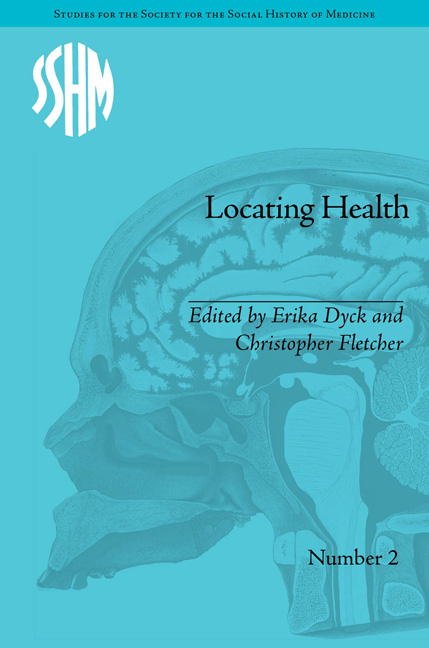Book contents
- Frontmatter
- CONTENTS
- List of Tables
- List of Contributors
- Acknowledgements and Preface
- Introduction: Healthscapes: Health and Place among and between Disciplines
- 1 Placing Maternal Health in India
- 2 Putting Medicine in its Place: The Importance of Historical Geography to the History of Health Care
- 3 Finding Place in The Big-Little World of Doc Pritham: Telling Medical Tales about Northwoods Maine, 1920s–70s
- 4 Putting Hyperactivity in its Place: Cold War Politics, the Brain Race and the Origins of Hyperactivity in the United States, 1957–68
- 5 Why Canada Has a Universal Medical Insurance Programme and the United States Does Not: Accounting for Historical Differences in American and Canadian Social Policies
- 6 Alberta Advantage: A Canadian Proving Ground for American Medical Research on Mustard Gas and Polio in the 1940s and 50s
- 7 Placing Illness in its Cultural Territory in Veracruz, Nicaragua
- 8 Chronic Disease in the Yukon River Basin, 1890–1960
- 9 An Ideal Home for the Consumptive: Place, Race and Tuberculosis in the Canadian West
- 10 Serbian Landscapes of Dreamtime and Healing: Clear Streams, Stones of Prophesy, St Sava's Ribs, and the Wooden City of Oz
- Notes
- Index
10 - Serbian Landscapes of Dreamtime and Healing: Clear Streams, Stones of Prophesy, St Sava's Ribs, and the Wooden City of Oz
- Frontmatter
- CONTENTS
- List of Tables
- List of Contributors
- Acknowledgements and Preface
- Introduction: Healthscapes: Health and Place among and between Disciplines
- 1 Placing Maternal Health in India
- 2 Putting Medicine in its Place: The Importance of Historical Geography to the History of Health Care
- 3 Finding Place in The Big-Little World of Doc Pritham: Telling Medical Tales about Northwoods Maine, 1920s–70s
- 4 Putting Hyperactivity in its Place: Cold War Politics, the Brain Race and the Origins of Hyperactivity in the United States, 1957–68
- 5 Why Canada Has a Universal Medical Insurance Programme and the United States Does Not: Accounting for Historical Differences in American and Canadian Social Policies
- 6 Alberta Advantage: A Canadian Proving Ground for American Medical Research on Mustard Gas and Polio in the 1940s and 50s
- 7 Placing Illness in its Cultural Territory in Veracruz, Nicaragua
- 8 Chronic Disease in the Yukon River Basin, 1890–1960
- 9 An Ideal Home for the Consumptive: Place, Race and Tuberculosis in the Canadian West
- 10 Serbian Landscapes of Dreamtime and Healing: Clear Streams, Stones of Prophesy, St Sava's Ribs, and the Wooden City of Oz
- Notes
- Index
Summary
After Milošević's fall in 2000, and the assassination of the Prime Minister Zoran Djindjić in 2003, the Serbian political scene has been characterized by the struggle of contending political groups to legitimate their visions of Serbian identity. One common method is to entrench these visions in political rituals situated at particular dates and places. As anchors for collective memory and narratives of national origin, both the calendar of official holidays, and the map of ‘famous historical places’ become battlegrounds for contesting agendas.
On the other hand, widespread concerns with pollution and purity, alternative healing methods, and various ‘energies’ – long associated in anthropological literature with anxieties over social boundaries or intrusions of global capitalism – tend to be anchored in the places purportedly endowed with special energies – the ‘places of power’.
By ‘places of power’ I mean named places that have become widely shared symbolic tokens in a particular polity because they accumulated many and varied layers of meaning. For instance, such places of renown or ‘power’ tend to act as ‘pegs’ or ‘anchors’ not only in the ‘national geography of the mind’, but also in the ‘social frameworks of memory’ on very intimate, personal and familial scales. In short, we need places to hang our life memories on, and the powers that be always seek to insert their ideology through these locations on which we drape our memories.
- Type
- Chapter
- Information
- Locating HealthHistorical and Anthropological Investigations of Place and Health, pp. 169 - 186Publisher: Pickering & ChattoFirst published in: 2014



